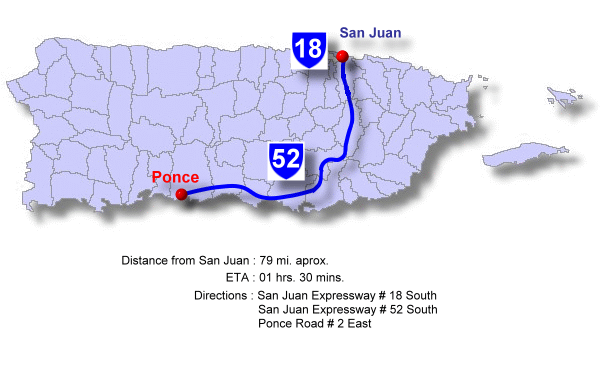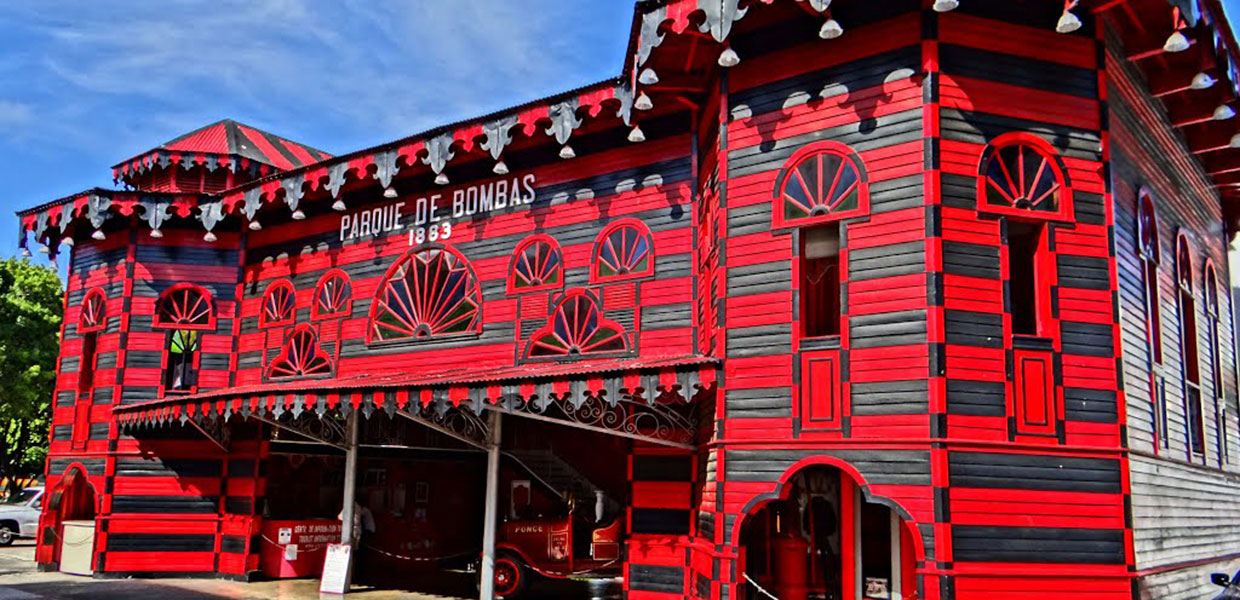
Ponce, Puerto Rico
Pearl of the South
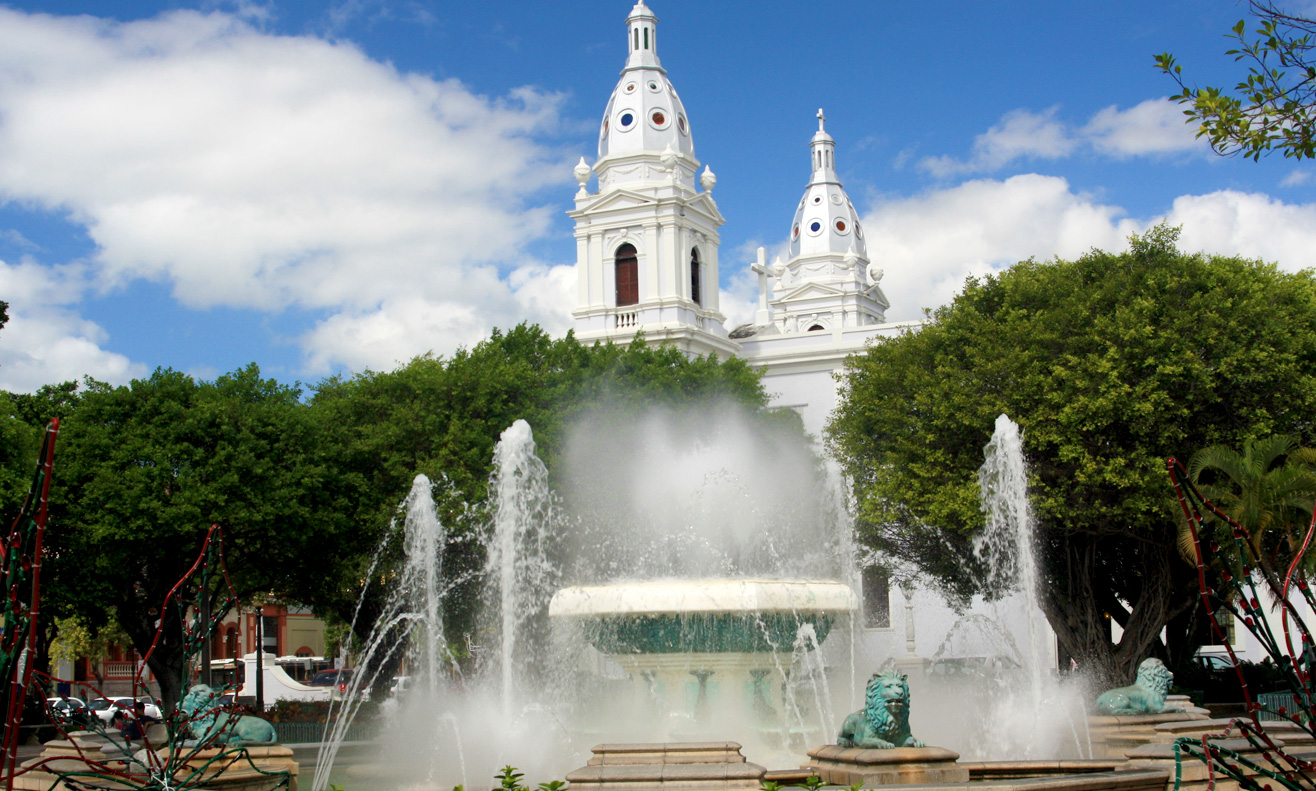
Ponce (PON-sai) is known as the “Pearl of the South,” the “Noble City,” “The Lions,” and the “Genip City”. The patroness of Ponce is Our Lady of Guadeloupe.
The municipality is located on the south coast of Puerto Rico. Is bordered on the north by Utuado and Jayuya, on the northwest by Adjuntas, on the south by the Caribbean Sea, on the east by Juana Díaz, and on the west by Peñuelas. The municipal territory reaches the central mountain range to the north and the Caribbean Sea to the south.
The city is also known for landmarks such as the Old Ponce Fire Station (1882); the Cathedral, the La Perla Theater (partially destroyed in the 1918 earthquake and rebuilt in 1941), the Art Museum, the Serrallés mansion, and the Vigía Cross. The Indigenous Ceremonial Park in Tibes Ward and the Caja de Muertos Lighthouse built in 1880 are also located in this municipality. Natural resources in Ponce include the Toro Negro forest, the El Tuque beach, Deadman’s Chest island, and Pelícano and Blanca beaches.
*Genip is one of the common names in English for Melicoccus bijugatus. The word used in Puerto Rico is quenepa. Other Spanish-speaking countries call the fruit mamoncillo.
Ponce is one of the most developed municipalities on the island, whose manufacturing sectors include electronic and electrical equipment, communications equipment, food processing, pharmaceuticals, concrete plants, and scientific instruments. Other industries include leather products, needlework, and fish flour. In the agricultural sector, the most import product is coffee, followed by plantains, bananas, oranges, and grapefruit, among others. Other economic activities include public and private services, finance, retail sales, and construction.
Foundation:
Ponce's historical importance goes back to the migratory period of the clans and pre-Columbian groups (archaic, ingeris, pre-Taíno and Taíno). These settled in the southwestern region of the country (between Ponce and Cabo Rojo) and founded the chieftainship of Guainía. The chief of this territory was Agüeybaná that, according to the chroniclers of the era was the chief of greatest authority in the Island.
In 1493 the Genoese admiral Christopher Columbus arrives at our coasts, but it was not until 1508 when the conquest of the Island began. It was through the southern region of Puerto Rico where our first Spanish governor Juan Ponce de León arrived. The city was named in his honor.
In the first years of the colonization, along the riviera of the Jacaguas river, the first Spanish families populated the area that today occupies the Independent Municipality of Ponce. Soon, this group, in search of greater security, settled in the fertile plains on the flanks of the river that the Indians called Barayama (today, Portugués river). Later, in 1670, they erected a small hermitage under the protection of Our Lady of Guadalupe. Around this same period the town was developed, officially recognized in 1692.
During the course of the eighteenth century and first half of the nineteenth century, Ponce experienced changes that were preparing it for the directive role that the population would take on from second half of the nineteenth century. From that time the population was growing, thus expanding its urban contour; progress that occurred in spite of the catastrophes (fires, storms, tremors and others) that to a certain extent prevented it. Another occurrence of significance at the time was the establishment of the first sugar cane mills in the region.
This factor was the base for the conversion of Ponce in an economic center of great importance in the southern region. This flourishing activity was in headed by a foreign landowner class, that by means of the slavery system converted the fertile grounds of Ponce into the main agricultural center of the country. Evidence of that economic development was always the well remembered Ponce Exhibition Fair of 1882, where the agricultural and industrial advances of Ponce and Puerto Rico were displayed. Today we have left from that period the Pavilion that today lodges the Fire House Museum.
In contrast to the living conditions that reigned in the island, Ponce emerged from town to villa (1848) and from villa to city (1877), until becoming what the historians of the country distinguished as the turn-of-the-century Alternative Capital of Puerto Rico.
During the second half of XIX century Ponce had become a progressive city-the economic, cultural and intellectual center of the south; some assert it was that center of the country. The main political figures of the country would congregate here to direct the changes that the colony demanded: assimilation, autonomy or separation. In the cultural scope, music, theater, opera, literary movements and journalism found in Ponce important means of expression.
At the end of XIX century, Ponce was a mosaic of diverse groups: Creoles, peninsulars, blacks, mulattos and other non-Hispanic European immigrants. On the other hand, its urban contour reflected the diversity of its citizens. It was the union of the human and physical element which gave Ponce its own profile that distinguished it from the rest of Puerto Rico; and which gave it its alternative character in contrast with the capital, San Juan.
This factor was the base for the conversion of Ponce in an economic center of great importance in the southern region. This flourishing activity was in headed by a foreign landowner class, that by means of the slavery system converted the fertile grounds of Ponce into the main agricultural center of the country. Evidence of that economic development was always the well remembered Ponce Exhibition Fair of 1882, where the agricultural and industrial advances of Ponce and Puerto Rico were exposed; and we have still have left the Pavilion that today lodges the Fire House Museum.
As opposed to the conditions of life that reigned in the Island, Ponce emerged from town to villa (1848) and from villa to city (1877), until becoming which the historians of the country distinguished Ponce as the turn-of-the-century Alternating Capital of Puerto Rico.
During the second half of XIX century Ponce had become a progressive city and the economic, cultural and intellectual center of the south; and there are some who affirm that of the country. The main political figures of the country would congregated, to direct the changes that the colony demanded, be it assimilation, autonomy or separation. In the cultural scope, music, theater, opera, literary movements and the journalistic task found in the City important means of expression.
At the end of XIX century, Ponce was a mosaic of diverse groups: Creoles, peninsulars, blacks, mulattos and other non Hispanic European immigrants. On the other hand, its urban contour reflected the idiosyncrasy of its citizens. It was the union of the human and physical element which gave Ponce its own profile that distinguished it from the rest of the Island; and which gave simultaneously the alternating character in contrast with the capital, San Juan.
Location:
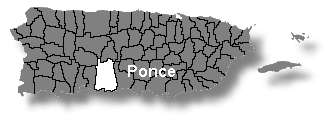 It is bordered by: Peñuelas on the west; Adjuntas on the nortwest; Utuado and Jayuya on the north; and Juana Díaz on the east.
It is bordered by: Peñuelas on the west; Adjuntas on the nortwest; Utuado and Jayuya on the north; and Juana Díaz on the east.
Area:
278.4 sq km / 116.0 sq mi
Population:
186,475 (census 2000)
Population Density:
669.8 per sq km / 1,607.5 per sq mi
People are known as:
Ponceños
Ponce is also known as:
La Perla del Sur (Pearl of the South)
Ciudad Señorial (Majestic City)
Wards: Ponce, Puerto Rico
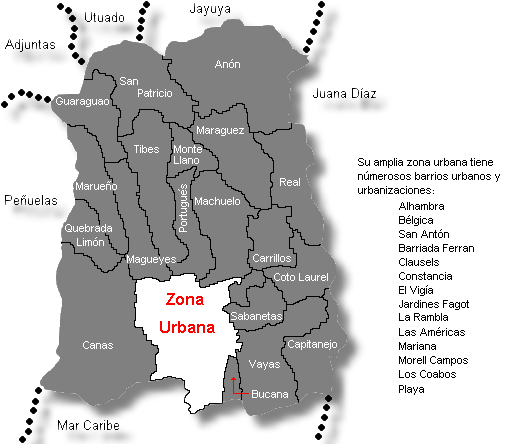
| Census 2000: Population by Wards - Ponce | Habitants |
| Anón | 1,669 |
| Bucaná | 3,963 |
| Canas | 34,065 |
| Canas Urbano | 21,482 |
| Capitanejo | 1,404 |
| Cerrillos | 4,284 |
| Coto Laurel | 5,285 |
| Cuarto | 3,011 |
| Guaraguao | 1,017 |
| Machuelo Abajo | 13,302 |
| Machuelo Arriba | 13,727 |
| Magueyes | 6,134 |
| Magueyes Urbano | 1,332 |
| Maragüez | 754 |
| Marueño | 1,474 |
| Monte Llano | 462 |
| Playa | 16,926 |
| Portugués | 4,882 |
| Portugués Urbano | 5,886 |
| Primero | 3,550 |
| Quebrada Limón | 804 |
| Quinto | 724 |
| Real | 3,139 |
| Sabanetas | 6,420 |
| San Antón | 11,271 |
| San Patricio | 465 |
| Segundo | 11,321 |
| Sexto | 4,745 |
| Tercero | 773 |
| Tibes | 866 |
| Vayas | 1,338 |
| Total | 186,475 |
Source: Censo 2000
Patrón:
Nuestra Señora de la Guadalupe
Nuestra Señora de la Guadalupe Parish
Plaza de las Delicias
P.O. Box 32210
Ponce, P.R. 00732-2210
(787) 842-0134
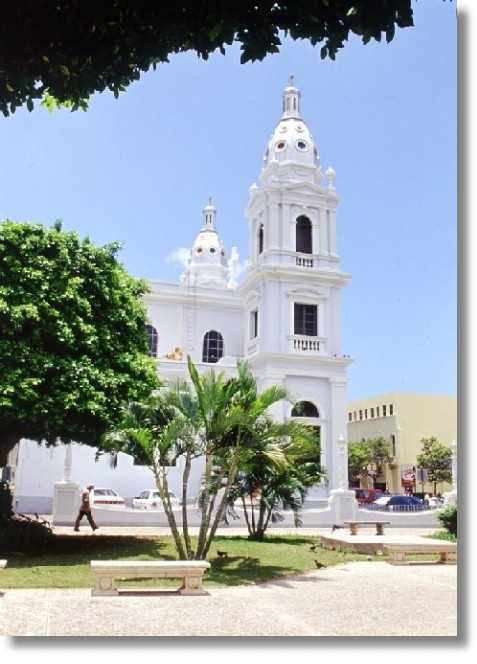
Topografía:
Geographically classified among the municipalities that belong to the Southern Coastal Plain, towards the north runs the Central Mountain Range.
Hidrografía:
Several gorges and rivers flow through the zone; most of them are intermittent courses. Most important is the Portugués river that flows through the urban zone. In the past it caused floods but it has been canalsh ave been dug to control the flow. It drains in the Bucana river and flow together into the port. The Cañas river runs by the west side and takes water from the Pastillo. The Cerrillos river flows from the Central Mountain Range and is dammed forming the reservoir of the same name. Futher down is the Bronce dam. Both dams are used for agriculture and domestic irrigation. In its beach the salt water Cucharas Lagoon is located.
Clima:
Ponce's climate is tropical semidesert. The annual precipitation average on the coast is 36 inches, in the interior 48 inches, and to the north close to the Central Mountain Range, 60 inches. Its temperature also varies within its ample geography. The coast has an annual average of 79°, the interior 76°, and in the mountains 72°.
Economy:
Commerce, tourism, manufacture (consumer products, clothing & cement) and customer services.
Average Salary:
$296.21 weekly (1998)
Flag:
 Above the traditional red and black colors of Ponce the shield of the city. The five tower gold crown indicates that Ponce is a city by royal decree. As an exterior frame to shield, we have interlaced, a sugar cane plant on the right and to the left a coffee tree branch. These products symbolize the principal economic means of the city in 1887, year that King Alfonso XII granted the right to become a city.
Above the traditional red and black colors of Ponce the shield of the city. The five tower gold crown indicates that Ponce is a city by royal decree. As an exterior frame to shield, we have interlaced, a sugar cane plant on the right and to the left a coffee tree branch. These products symbolize the principal economic means of the city in 1887, year that King Alfonso XII granted the right to become a city.
Coat Of Arms:
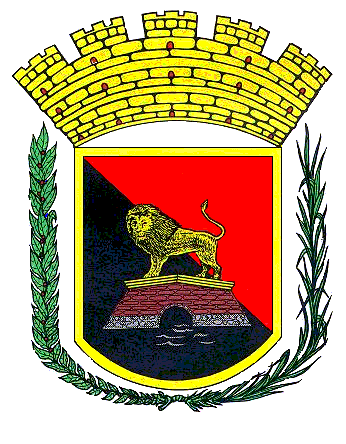 The shield of Ponce is divided by a diagonal line that crosses straight from the superior end to the left inferior end. In this divided field is the color red, that covers the superior right portion, symbol of fire and strength and the black that covers the left inferior portion representing the night, repentance, prudence and modesty. On that black and red background is a yellow lion with black mane, walking towards the left of the shield, facing - looking - towards the right. The lion is on a bridge that is a representation of the rivers. The shield is bordered by a coffee plant branch and a sugar cane plant, crops that in their time were of great importance for the town.
The shield of Ponce is divided by a diagonal line that crosses straight from the superior end to the left inferior end. In this divided field is the color red, that covers the superior right portion, symbol of fire and strength and the black that covers the left inferior portion representing the night, repentance, prudence and modesty. On that black and red background is a yellow lion with black mane, walking towards the left of the shield, facing - looking - towards the right. The lion is on a bridge that is a representation of the rivers. The shield is bordered by a coffee plant branch and a sugar cane plant, crops that in their time were of great importance for the town.
Events:
- Ponce Carnival – the week before Lent
- Regional Crafts Fair – March
- Ponce Playa Festival – May
- Danza Week – May
- Bomba Festival in San Antón Ward – July
- Patron Saint’s Day Festival – December
- Discovering our Indian Roots – November
- Matins in Honor of Our Lady of Guadeloupe – December
- Christmas Concert – December
Places of interest:
- Old Customs
- Old Casino of Ponce
- Old infantry quarters
- Toro Negro State Forest
- Miguel Pou Boulevard
- 25 of Enereo Street
- City hall
- Traditional Urban Center of Ponce
- Ponce Yacht Club
- Cruceta El Vigía (Japanese Garden)
- Hacienda Buena Vista
- Monument to Women
- Ponce Art Museum
- Paoli House Museum
- Ceiba tree park
- Old Ponce Fire Station "Parque de Bombas"
- Enrique González Park
- Pedro Albizu Campos Monument Park
- Julio E. Monagas Recreational Park
- Tricentennial Park
- Dora Colón Clavell Urban Park
- Armstrong-Ponventud House
- Wiechers-Villaronga House
- Serrallés Castle
- Cathedral Our Lady of Guadalupe
- Tibes Indigenous Ceremonial Center
- Francisco “Pancho” Coimbre Museum
- Ponce History Museum
- Ponce Massacre Museum
- Puerto Rican Music Museum
- National Pantheon Román Baldorioty de Castro
- Antonio Arias Ventura Walk
- Atocha walk
- La Guancha boardwalk
- Las Delicias Square
- Plaza del Caribe Mall
- Veredas del Labrador
- Villa Pesquera
- Juan Ponce de León Square
- Isabel II Market Square
- La Perla Theater
Beaches:
- El Tuque Beach
- La Guancha
- Punta Salinera Beach
- Las Salinas Beach
- Cañas Beach
- Las Cucharas Beach
- Gatas Island Beach
- Chencha Beach
- Los Meros Beach
- Ponce Beach
- The Malecon
- Ponce Yacht and Fishing Club
- Caja de Muertos Island
- Matilde Beach
- Ensenadita Beach / Pocitas Beach
- Hilton Beach
- Punta Cabuyón Beach / Punta Cabullones
- Vayas Beach
Ponce Offshore Beaches:
- Isla de Ratones
- Larga Beach
- Ensenadita Beach / Pocitas Beach
- Pelican Beach
- Cardona Island
- Coast Guard
- Blanca Beach
- Carrucho Beach / Chica Beach
Distinguished Citizens:
- Alfredo M. Aguayo – Educator and writer. Professor at the University of Havana in Cuba. A member of the Cuban Academy of History. Because of his outstanding career as an educator, the School of Education at the University of Havana bears his name.
- Pedro Albizu-Campos – A leader of the Puerto Rican nationalist movement who left a profound mark in his country’s history. He presided the Nationalist Party and spent many years in prison for defending the independence struggle.
- María Teresa Babín – Educator and essayist who has also written poetry and plays. Her best-known works include Panorama de la cultura puertorriqueña and several essays on Federico García Lorca.
- Vicente Balbás-Capó – Journalist and political figure, a defender of the Spanish colonial regime. During the Spanish-American War Balbás-Capó organized a volunteer battalion and was imprisoned for his opposition to Puerto Ricans serving in the United States armed forces.
- Héctor Campos-Parsi – One of the most important contemporary Puerto Rican composers. Author of two important essays on Puerto Rican music.
- Carlos E. Chardón-Palacios – Scientist and essayist. Chardón held important public positions, notably in the financial sector; he promoted an economical proposal known as the Plan Chardón in 1935. Among other works, Chardón wrote an excellent essay on Simón Bolívar, for which he was decorated by the Venezuelan government with the Order of the Liberator.
- Arístides Chavier-Arévalo – Musician and composer of the modernist period. Chavier wrote the Puerto Rico Overture and the essay “El arte musical puertorriqueño: su desarrollo y evolución hasta el presente”, in 1923.
- Federico Degetau-González – A liberal political figure and writer; delegate to the Spanish Cortes and resident commissioner in Washington (1901 – 1905).
- Ruth Fernández-Corrada – Signer of international renown. Senator and director of the Governor’s Cultural Affairs Office.
- Luis A. Ferré-Aguayo – Engineer, pianist, founder of the New Progressive Party (1967); Ferré was a senator (1977 – 1985) president of the Senate (1977 – 1981), and governor of Puerto Rico (1968-1972). He also was a patron of the arts and founder of the Museo de Arte de Ponce (1959).
- Félix Franco-Oppenheimer – Poet and writer. His works include Contornos, Imagen y visión edénica de Puerto Rico and Antología poética.
- Julio J. Henna – Physician. Henna participated in the founding of the Puerto Rico Section of the Cuban Revolutionary Party in New York. He later supported the annexation of Puerto Rico to the United States.
- Rafael Hernández-Colón – Attorney, secretary of justice (1964-1968), President of the Senate (1968-1972), and Governor of Puerto Rico (1972-1976, 1984-1988, 1988-1992).
- Antonio S. Luchetti -Public servant, engineer. Under his initiative, the electric power system was established and developed in Puerto Rico under the Puerto Rico Water Resources Authority (PRWRA).
- Washington Llorens – Linguist, poet, and essayist. His works include El español de Puerto Rico and El habla popular de Puerto Rico.
- Juan Morel-Campos – A great composer and musician. Although Manuel G. Tavárez is recognized as “the Father of the Puerto Rican danza,” it was Morel Campos who perfected the danza, based on Tavarez’s habanera style. His compositions include: Sopapos, Alma sublime, Felices días, Laura y Georgina, Sueño de amor, and Vano empeño.
- Antonio E. Paoli-Marcano – A singer of international renown, known as “The tenor of kings” and “The king of tenors.”
- Olga Albizu – abstract painter
- César Andreu-Iglesias – journalist, writer
- Rosario Ferré-Ramírez de Arellano – writer, profesor and member of the Academia Puertorriqueña de la Lengua. Has written fiction, poetry, essays and was the director of the journal Zona de Carga y descarga in 1970.
- Raúl Gándara-Cartagena -A fire chief; he wrote a book on the firemen’s service in 1951, which became a manual in several Latin American countries.
- Elías López-Sobá - pianist, professor
- Elisa Tavárez – daughter of the “Father of the danza” Manuel G. Tavárez, a pianist of international renown.
- Mariano Villaronga-Toro - Commissioner of Public Education (1946).
- Emilio J. Pasarell – Writer, journalist and poet. Pasarell wrote about the origins of the theater in Puerto Rico.
- Miguel Pou-Becerra – Painter of countryside genre paintings, among them: Camino del pueblo, El bohío de yaguas, El flamboyán, Lavanderas del River Portugués, and Paisaje de montaña.
Ponce public schools.
Ponce District
| Name | Level | Telephone | Address |
| ANDRÉS GRILLASCA SALAS | Elementary | (787) 842-6414 | PO Box 119 |
| ANSELMO RIVERA MATOS | Elementary | (787) 843-7938 | PO Box 2000 Suite 18 |
| CERRILLO HOYOS | Elementary | (787) 848-8793 | PMB 025 |
| DR. JOSÉ C. BARBOSA | Elementary | (787) 842-8671 | PO Box 334586 |
| HERMINIA GARCÍA | Elementary | (787) 840-6455 | 9 Calle E |
| JOSÉ GAUTIER BENÍTEZ | Elementary | (787) 844-3035 | PO Box 7856 |
| JOSÉ JULIÁN ACOSTA | Elementary | (787) 842-5175 | PO Box 7856 |
| JUAN MOREL CAMPOS | Elementary | (787) 842-5343 | Calle León Final |
| JULIO COLLAZO | Elementary | (787) 843-7939 | PO Box 2000 Suite 18 |
| LA YUCA | Elementary | (787) 843-4776 | PO Box 6805 |
| LAS MONJITAS | Elementary | (787) 843-1212 | PO Box 662 |
| LAS RAÍCES | Elementary | (787) 842-4418 | Suite 295 |
| LIZZIE GRAHAM | Elementary | (787) 842-0255 | PO Box 10756 |
| LLANOS DEL SUR | Elementary | (787) 848-1105 | PO Box 839 |
| LUIS MUÑOZ RIVERA I | Elementary | (787) 841-6008 | PO Box 2000 Suite 21 |
| LUIS MUÑOZ RIVERA II | Elementary | (787) 843-1715 | G-6 Villa Esperanza |
| MONTE LLANOS | Elementary | (787) 843-5910 | PO Box 2000 Suite 18 |
| PARCELAS REAL | Elementary | (787) 842-3007 | Suite 295 |
| PEDRO J. FOURNIER | Elementary | (787) 842-8974 | Suite 295 |
| RAMIRO COLÓN COLÓN | Elementary | (787) 842-0376 | 10 Calle Lolita Tizol |
| RODULFO DEL VALLE | Elementary | (787) 844-1265 | Drawer 459 |
| ROMÁN BALDORIOTY DE CASTRO | Elementary | (787) 843-2235 | PO Box 336504 |
| SANTA TERESITA | Elementary | (787) 841-4949 | Calle 23 Esquina 24 |
| SIMON MORET GALLART | Elementary | (787) 843-5154 | PO Box 7856 |
| TOMÁS CARRIÓN MADURO | Elementary | (787) 843-7280 | 301C Drawer 477 |
| ABRAHAM LINCOLN | Elementary | (787) 842-0117 | 46 Campeche |
| ÁNGELA CORDERO BERNARD | Elementary | (787) 844-4020 | PO Box 7496 |
| ÁUREA E. RIVERA COLLAZO | Elementary | (787) 841-0328 | PO Box 8643 |
| CAPITANEJO | Elementary | (787) 837-6302 | PO Box 566 |
| CARMEN MEDINA ANAYA | Elementary | (787) 841-1214 | PO Box 7393 |
| CARMEN SOLÁ DE PEREIRA | Elementary | (787) 841-6411 | PO Box 10685 |
| DR. RAFAEL LÓPEZ NUSSA | Elementary | (787) 842-7170 | PO Box 10577 |
| DR. RAMÓN E. BETANCES | Elementary | (787) 844-8651 | PMB 248 PO Box 7105 |
| EUGENIO MARÍA DE HOSTOS | Elementary | (787) 844-5884 | 2049 Eduardo Ruberte |
| FERNANDO L. MALAVÉ OLIVERAS | Elementary | (787) 843-2048 | PO Box 7851 |
| FRANCISCO PARRA DUPERON | Elementary | (787) 842-5257 | PO Box 7105 |
| JAIME L. DREW | Elementary | (787) 842-7343 | PO Box 7025 |
| JOAQUÍN FERRAN | Elementary | (787) 842-0014 | PO Box 7105 |
| JOSEFINA BOYA LEÓN | Elementary | (787) 840-3770 | PO Box 464 |
| JUAN CUEVAS ABOY | Elementary | (787) 843-3895 | PO Box 7571 |
| JULIA CORDERO NEGRÓN | Elementary | (787) 843-8248 | PO Box 7855 |
| JULIO ALVARADO | Elementary | (787) 844-7048 | PO Box 10091 |
| LIBRADO NET | Elementary | (787) 842-6395 | Urb. San Antonio 50 Calle |
| LUCY GRILLASCA | Elementary | (787) 842-4010 | 1615 Ave. Eduardo Ruberte |
| MERCEDES P SERRALLÉS | Elementary | (787) 843-6170 | PO Box 566 |
| OLIMPIO OTERO | Elementary | (787) 842-5197 | 440 Calle Villa Final |
| PARCELAS MAGUEYES | Elementary | (787) 843-4403 | PO Box 7025 |
| PARCELAS MARUEÑO | Elementary | (787) 841-5332 | PO Box 7025 |
| SEGUNDO RUIZ BELVIS | Elementary | (787) 840-3400 | PO Box 30268 |
| ANTONIO PAOLI | Intermediate | (787) 844-0615 | PO Box 6960 |
| DR. RAFAEL PUJALS | Intermediate | (787) 840-4600 | PO Box 330726 |
| ERNESTO RAMOS ANTONINI | Intermediate | (787) 843-2336 | PO Box 7856 |
| JARDINES DE PONCE | Intermediate | (787) 844-3400 | LA Rambla Suite 394 |
| JUAN SERRALLÉS (INTERMEDIA) | Intermediate | (787) 848-2005 | PO Box 1073 |
| MANUEL GONZÁLEZ PATO | Intermediate | (787) 841-7216 | 301 C Suite 395 |
| DR. PEDRO ALBIZU CAMPOS | Intermediate | (787) 841-2548 | PO Box 7393 |
| EDUARDO NEUMANN GANDIA | Intermedia | (787) 840-0112 | PO Box 7025 |
| EUGENIO LE COMPTE | Intermediate | (787) 844-4552 | PO Box 7091 |
| HEMETERIO COLÓN | Intermediate | (787) 840-3500 | 21 Calle Concordia |
| ISMAEL MALDONADO LUGARO | Intermediate | (787) 843-2135 | PO Box 263 |
| SANTIAGO GONZÁLEZ | Intermediate | (787) 842-5028 | PO Box 7025 |
| SOR ISÓLINA FERRE | Intermediate | (787) 840-6075 | PO Box 30067 |
| INSTITUTO TECN. | PS - Institute | (787) 843-0935 | PO Box 7284 |
| FEDERICO DEGETAU Y GONZÁLEZ | Secondary | (787) 842-6178 | PO Box 336217 |
| ROSARIO LA TORRE MORALES | Secondary | (787) 843-5099 | PO Box 7226 |
| JUAN SERRALLÉS | Secondary | (787) 848-5274 | PO Box 1136 |
| JARDINES DE PONCE | High School | (787) 840-7785 | PO Box 780 |
| THOMAS ARMSTRONG TORO | High School | (787) 844-3388 | PO Box 336921 |
| BERNARDINO CORDERO BERNARD | High School | (787) 842-7091 | PO Box 10478 |
| BETHZAIDA VELÁSQUEZ | High School | (787) 284-1080 | PO Box 7636 |
| DR. ALFREDO M. AGUAYO | High School | (787) 843-1305 | 137 Avenida Hostos |
| DR. PILA | High School | (787) 840-4800 | PO Box 2238 |
| PONCE HIGH SCHOOL | High School | (787) 842-4156 | PO Box 109 |
| BELLAS ARTES DE PONCE | All Levels | (787) 259-737 | 20 Calle Tizol |
| CENTRO DE SERVICIOS EDUCATIVOS | All Levels | (787) 844-0965 | PO Box 336837 |
| JUAN MOREL CAMPOS (MÚSICA) | All Levels | (787) 842-3974 | PO Box 4087 |
| RAMÓN MARÍN | All Levels | (787) 842-1371 | PO Box 10788 Suite 188 |
Hymn:
Author Dr. Angel Luis Rodríguez Rosado
¡Oh, Ponce! En mi corazón
cuando oigo tu nombre
yo siento el rugido
de un fiero león.
Borinque nunca olvidará
que al son de la danza,
la bomba y la plena
la hiciste bailar.
Tu Parque de Bombas es ya
templo de una historia
que tu Vieja Ceiba
ha visto pasar...
¡Ponce! Siempre serás tú
joya que mirarte
habrá que llamarte
La Perla del Sur.
Tu rojo y negro pabellón
bandera es de gloria
que en toda victoria
es tu inspiración.
Tu Parque de la Abolición
recuerda la lucha
de tus bravos hijos
por la libertad.
En coche quiero disfrutar
las dulces quenepas
y ver tus encantos
Ciudad Señorial...
¡Ponce! Siempre serás tú
joya que al mirarte
habrá que llamarte
La Perla del Sur.

